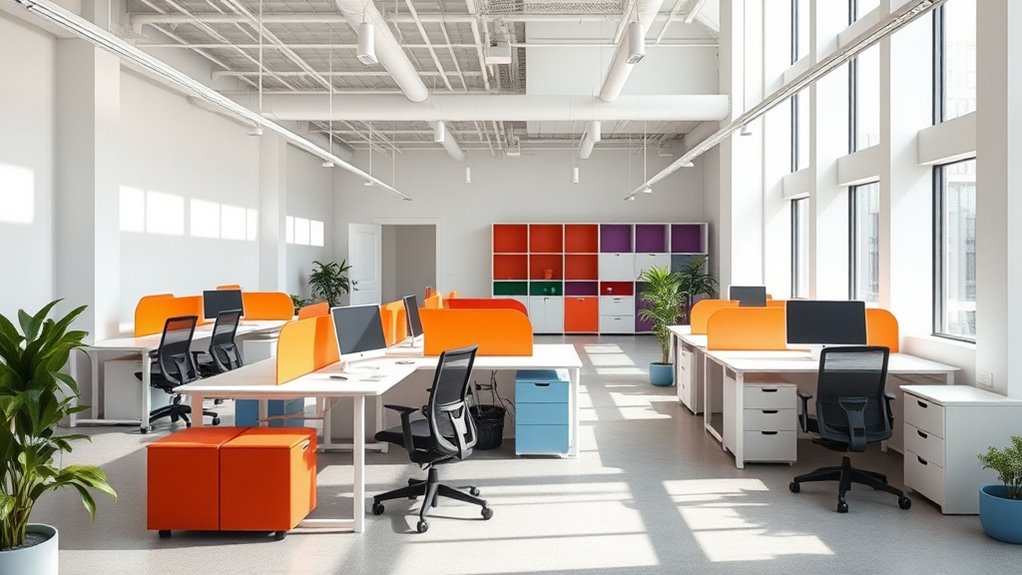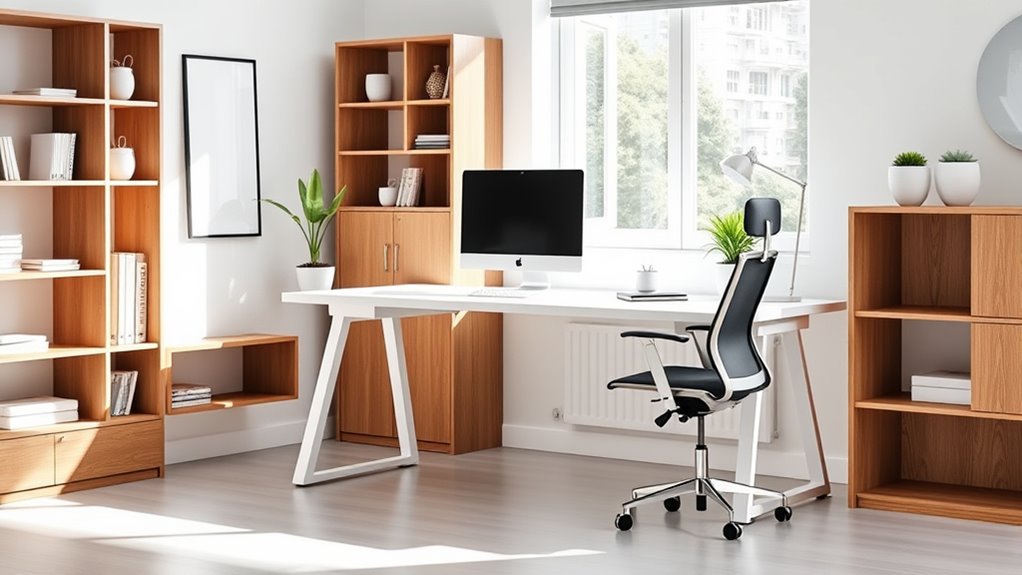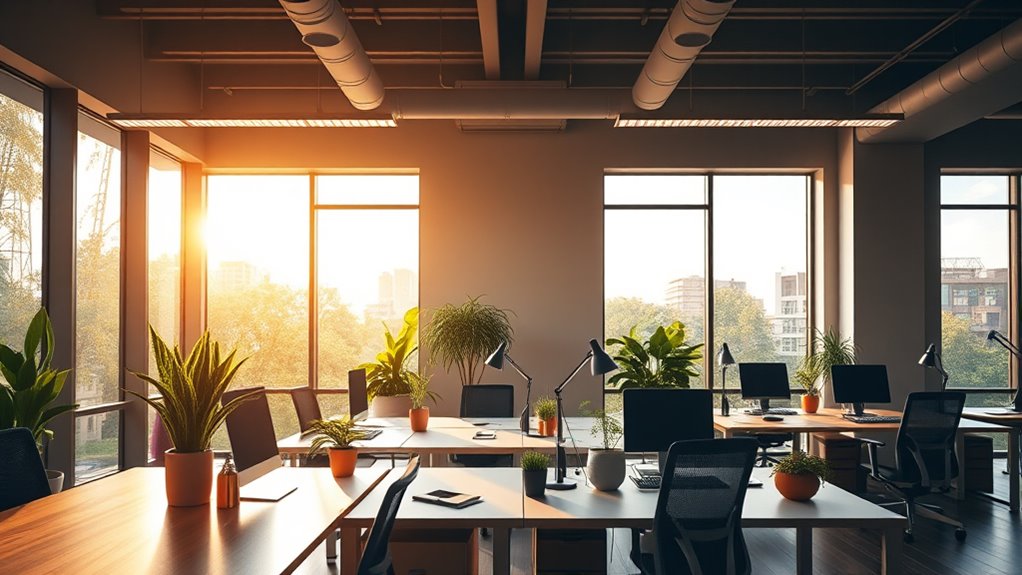To create a productive office space, start by evaluating your current layout and needs, noting underused areas and gathering employee feedback. Prioritize flexible, modular furniture that can adapt to various tasks, and select ergonomic, stylish pieces to keep employees comfortable and motivated. Optimize lighting with natural and adjustable sources, use calming colors, and incorporate technology for seamless workflow. Adding personal touches boosts morale—continue exploring detailed tips to transform your office into an inspiring work environment.
Key Takeaways
- Assess current layout and employee needs to identify bottlenecks, underused areas, and workflow patterns.
- Incorporate modular furniture and flexible zones to support adaptability and team collaboration.
- Choose ergonomic, stylish furniture and personalize spaces to enhance comfort and employee morale.
- Maximize natural light and use strategic artificial lighting to improve mood and productivity.
- Integrate smart technology and personal touches to streamline workflows and boost employee engagement.
Assessing Your Current Office Layout and Needs

Before planning any office makeover, you need to understand your current space and how it serves your team. Walk through your office and observe how areas are used daily. Note which zones foster collaboration and which feel isolated or underused. Talk to your employees about their experiences—what works, what doesn’t, and what they need to be more productive. Measure the space carefully, including storage and traffic flow. Identify bottlenecks or clutter that hinder efficiency. Consider your company’s goals and whether your current layout aligns with them. This assessment reveals strengths and weaknesses, helping you prioritize improvements. Additionally, understanding your space utilization can guide your decisions on furniture and layout changes. Recognizing how your space is currently organized enables you to address specific inefficiencies more effectively. Analyzing your hours of operation can also help you optimize your space for better accessibility and convenience. By understanding your existing setup, you set a solid foundation for a makeover that truly enhances your workspace. Incorporating insights from interior design planning ensures your office layout supports both functionality and aesthetic appeal. Furthermore, analyzing workflow patterns can help optimize your office for better productivity and employee satisfaction.
Prioritizing Functionality and Flexibility in Design

To create a flexible office space, consider using modular workstations that can be easily reconfigured for different needs. Opt for multi-purpose furniture that saves space and adapts to various tasks, like fold-away desks or movable partitions. Adjusting layouts and zones regularly helps you stay agile and guarantees your office supports both collaboration and individual focus. Incorporating open space principles can further enhance flexibility and promote a more adaptable work environment.
Modular Workspace Options
Have you considered how modular workspace options can transform your office into a versatile and efficient environment? These adaptable solutions allow you to customize layouts quickly, optimize space, and support changing needs. Modular furniture and partitions can be rearranged for individual focus, team collaboration, or social areas. They’re ideal for dynamic workplaces that require flexibility without sacrificing functionality. To help visualize, here’s a quick look at key modular options:
| Flexibility Level | Ideal Use Cases | Benefits |
|---|---|---|
| High | Hot-desking, team zones | Easy reconfiguration, scalability |
| Medium | Private offices, meeting rooms | Balance between privacy and openness |
| Low | Fixed workstations | Stability, minimal rearrangement |
Implementing these options effectively often involves understanding reconfiguration techniques to maintain productivity during workplace adjustments. These choices empower you to create an adaptable, productive office environment. Personal development principles such as goal setting and self-reflection can also enhance your ability to implement effective workspace strategies.
Multi-purpose Furniture Choices
Multi-purpose furniture plays a crucial role in creating a flexible and functional office space. It allows you to maximize limited areas by combining multiple functions into single pieces. For example, choose desks with built-in storage or foldable tables that can serve as work surfaces and meeting spots. Modular seating that transforms into lounge areas or additional workstations offers adaptability throughout the day. Consider height-adjustable desks that can switch between sitting and standing positions, promoting comfort and health. Storage ottomans provide seating while offering hidden compartments for supplies. These versatile pieces help you optimize your workspace, reduce clutter, and support different activities without sacrificing style or comfort. Prioritizing multi-purpose furniture ensures your office remains adaptable, efficient, and conducive to productivity. Regular assessment and rotation of items can help prevent clutter buildup and maintain the functionality of your space.
Adjustable Layouts and Zones
Implementing adjustable layouts and zones in your office design allows you to seamlessly adapt to changing needs throughout the day. Flexibility guarantees that spaces can serve multiple purposes, boosting productivity and comfort. Use movable partitions, modular furniture, and designated zones for collaboration, quiet work, or socializing. This approach helps you optimize space and meet diverse work styles. Consider creating zones like focus areas, meeting zones, and break spaces that can be reconfigured easily. Here’s a simple visualization:
| Zone Type | Furniture/Features | Purpose |
|---|---|---|
| Focus Area | desks, soundproof booths | Deep work |
| Collaboration Zone | large tables, whiteboards | Team projects |
| Break Space | lounge chairs, kitchen area | Rest and informal chats |
Selecting Ergonomic and Stylish Furniture

Choosing the right furniture is essential for creating a workspace that is both comfortable and visually appealing. Focus on ergonomic pieces that support good posture, like adjustable chairs and desks, to prevent discomfort and boost productivity. Look for stylish options that match your office’s design theme, using colors and materials that reflect your brand or personal taste. Prioritize quality and durability to ensure your furniture lasts, reducing the need for frequent replacements. Incorporate ergonomic accessories, such as footrests or lumbar supports, to enhance comfort. Additionally, selecting furniture compatible with headphones can improve your audio experience during work or breaks. Considering the unique needs of different work environments, such as office space makeovers, can optimize your layout and functionality. Well-chosen ergonomic and stylish furniture transforms your office into a space where you can work efficiently and feel good doing it. Incorporating natural elements like plants or planters can also improve air quality and promote a calming atmosphere. Integrating unique and wicked planters into your office decor can also add a touch of creativity and greenery, fostering a more inspiring environment. Furthermore, understanding regional resources and tools can help you select the best furniture options available locally, ensuring quality and support.
Optimizing Lighting for Comfort and Productivity

Since good lighting considerably impacts both comfort and productivity, optimizing your office lighting should be a top priority. Proper lighting reduces eye strain, enhances focus, and boosts mood. Natural light is ideal, so position your desk near windows when possible. Complement it with layered lighting: ambient, task, and accent. Use adjustable fixtures to control brightness levels. Consider color temperature; cooler tones energize, while warmer tones promote relaxation. To help you optimize, here’s a quick guide:
| Lighting Type | Best Use | Tips |
|---|---|---|
| Natural Light | Daytime productivity | Maximize with light curtains |
| Task Lighting | Focused work tasks | Use adjustable desk lamps |
| Ambient Light | Overall room illumination | Install dimmable overhead lights |
This balance guarantees comfort and efficiency throughout your workday. Additionally, incorporating layered lighting ensures flexibility in adjusting the environment to suit different tasks and times of day. Enhancing your workspace with appropriate lighting can also minimize disruptions and create a more inviting atmosphere.
Incorporating Color Psychology and Aesthetic Elements

After optimizing your lighting setup, the next step is to contemplate how color and aesthetic choices influence your workspace. Colors impact mood and productivity—blue promotes calm focus, while yellow energizes creativity. Choose hues that align with your work style and desired atmosphere. Incorporate aesthetic elements like artwork, plants, or decorative accessories to create visual interest and personalize your space. A balanced color scheme helps reduce stress and fosters clarity. Keep in mind that too many bold colors can be distracting, so opt for a cohesive palette that feels harmonious. Textures and patterns also contribute to the overall vibe. By thoughtfully selecting colors and aesthetic details, you craft an environment that motivates you and enhances your efficiency throughout the workday. Additionally, understanding the value of your environment’s impact on your productivity can lead to more intentional design choices. Incorporating aesthetic elements such as artwork or decorative accents not only enhances visual appeal but can also positively influence your emotional well-being and focus during work. Furthermore, selecting appropriate lighting and support hours can optimize your workspace’s comfort and functionality, creating an ideal environment for sustained productivity. Recognizing the importance of color psychology can further help you tailor your space to support your specific work habits and emotional needs. Considering ergonomic design can also improve comfort and reduce fatigue, ultimately boosting your overall work performance.
Integrating Technology for Seamless Workflow

Integrating smart devices and cloud storage can considerably boost your office’s efficiency. These tools enable you to stay connected and access files from anywhere, streamlining daily tasks. By adopting these technologies, you create a seamless workflow that keeps your team productive and agile.
Smart Device Integration
Smart device integration is essential for creating a seamless workflow in your office space. When your devices work together effortlessly, you save time and reduce frustration. Start by syncing your smartphones, tablets, and computers to share files instantly. Use smart assistants like Alexa or Google Home to set reminders or control office devices with voice commands. Implement smart lighting and thermostats to optimize comfort and energy efficiency. Consider wireless charging stations for quick device power-ups. Automate routine tasks, such as scheduling meetings or activating security systems, with smart home hubs. Incorporating device interoperability principles can optimize your office environment’s energy use and system responsiveness for a more efficient workspace. Selecting compatible devices that support unified control platforms can further enhance your overall automation capabilities. Ensuring your devices are connected through privacy-conscious settings helps protect sensitive office information while maintaining seamless functionality. Additionally, adopting interoperable systems can streamline device management and improve overall productivity.
Cloud Storage Solutions
Have you considered how cloud storage solutions can transform your office workflow? By storing files in the cloud, you guarantee quick, secure access from any device or location. This eliminates the need for physical drives or emailing documents back and forth, saving you time and reducing errors. Cloud solutions also enable seamless collaboration—team members can edit files simultaneously, with changes saved automatically. You can set permissions to control who sees what, maintaining security. Integration with other tools like project management apps or communication platforms simplifies daily tasks. Plus, cloud storage scales with your business, so you pay only for what you need. Cookies and Privacy Settings are important considerations when choosing online tools, ensuring your data remains secure and compliant. Overall, it streamlines your operations, making your team more flexible, responsive, and efficient. Choosing the right cloud storage provider ensures optimal performance and security tailored to your business needs.
Adding Personal Touches to Boost Employee Morale

Adding personal touches to the office can considerably boost employee morale by making the workspace feel more welcoming and reflective of individual personalities. When you let employees personalize their areas, they feel more comfortable and valued. Consider encouraging staff to bring in photos, artwork, or small decorations that inspire them. You can also set up communal spaces for shared interests, like book or hobby corners. Hosting regular theme days or personalization contests adds fun and engagement. Additionally, providing adjustable lighting or ergonomic accessories allows personal comfort adjustments. These simple gestures foster a sense of ownership and connection to the workspace, increasing motivation and happiness. Remember, a personalized environment isn’t about clutter; it’s about creating a space where employees feel truly at home.
Frequently Asked Questions
How Can I Ensure My Office Design Accommodates Future Growth?
To guarantee your office design accommodates future growth, you should plan flexible layouts that can easily adapt to changing needs. Incorporate modular furniture, scalable infrastructure, and versatile shared spaces. Prioritize open areas that can be reconfigured and add extra wiring or power sources for expansion. Regularly assess your team’s evolving requirements and keep a buffer in your design budget, so upgrading or expanding becomes seamless as your business grows.
What Are Cost-Effective Ways to Upgrade an Outdated Office Space?
Think of your office as a garden—you want it to flourish without breaking the bank. To upgrade cost-effectively, focus on fresh paint, swapping out old furniture for multipurpose pieces, and adding plants for a lively feel. You can also update lighting with affordable LEDs and declutter to boost productivity. These small changes can transform your space into a more inviting, efficient workplace without draining your resources.
How Do I Balance Open Space With Private Areas?
Balancing open space with private areas can boost productivity and comfort. You should create designated zones for focused work, like quiet rooms or booths, while keeping open areas for collaboration. Use movable partitions or furniture to easily adapt spaces as needed. Prioritize visual privacy with screens or plants, and make certain all areas have proper acoustics. This way, you give everyone the flexibility they need without sacrificing the benefits of an open layout.
What Are the Best Practices for Soundproofing in Shared Offices?
Soundproofing in shared offices is like putting a lid on a boiling pot—necessary to keep things quiet. You should add acoustic panels to absorb noise, install carpets or soft flooring to dampen sound, and use white noise machines to mask disturbances. Additionally, consider individual privacy booths or cubicles for focused work. These steps help create a calmer environment, boosting productivity and employee satisfaction.
How Can I Incorporate Eco-Friendly Materials Into Office Design?
Incorporating eco-friendly materials into your office design is a smart move. You can start by choosing furniture made from recycled or sustainably sourced wood. Use low-VOC paints and adhesives to improve indoor air quality. Incorporate natural elements like bamboo flooring or cork panels. Add plenty of plants to boost air purification and create a calming atmosphere. These choices help you create a healthier, more sustainable workspace that benefits both the environment and your team.
Conclusion
As you finish your office makeover, imagine the buzz of productivity filling the space, and employees feeling inspired in their new environment. Sometimes, a simple redesign can transform your entire workday, making tasks feel more manageable and even enjoyable. You might find that a fresh coat of paint or a well-placed plant sparks creativity unexpectedly. In the end, creating a space that works for you can lead to surprises—like newfound motivation just waiting to be opened.










